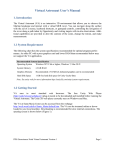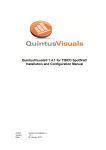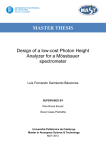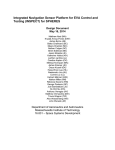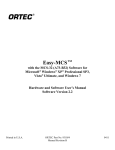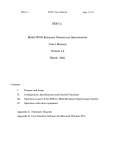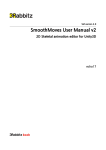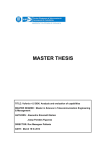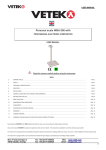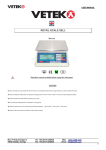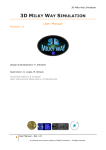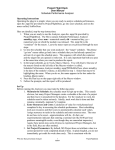Download User`s Manual - Virtual Astronaut - Washington University in St. Louis
Transcript
User’s Manual The Virtual Astronaut (VA) is a virtual 3D environment that allows users to observe the Martian landscape and interact with a virtual MER rover. An astronaut can navigate along the surface with the aid of a mouse, keyboard shortcuts, or gamepad controls. He or she can control the animation of a rover driving a path taken by Opportunity and can also visit targets with in-situ observations. Additional capabilities are provided to alter the contrast of the scene, change the terrain, and make measurements. A toolbar with 7 icons is located in the upper left of the screen. There is a slider underneath the toolbar for adjusting the size of the toolbar and icons. Each icon function is briefly introduced below. Please refer to the following for more details of each of the function. Animation Mode: This mode controls the animation of a rover drive along a traverse taken by Opportunity. Target Mode: In-situ observations with high-resolution data collected from MER rovers can be viewed in this mode. Measurement Tool: This tool measures the dimension of a feature. Terrain Tool: This tool adjusts the terrain vertical exaggeration factor and controls the visibility of different layers of image mosaics. Help Tool: This tool directs you to the webpage with VA user’s scenario and user’s manual. Contrast Tool: This tool adjusts the contrast/brightness of a scene. Reset Tool: This tool resets the scene to the initial positioning. How to Navigate through the Scene The VA supports navigation with a mouse, keyboard shortcuts, or a gamepad. Navigation in the VA uses viewpoint (eye) controls that allow the user to move around the terrain, to look into or out of the scene, and to look left, right, up, and down as if you were an astronaut. For example, when left clicking the mouse on the scene, the screen’s movement follows the user’s mouse as if you were pointing in the direction you wish to move. The navigation simulates the perspective of an astronaut walking on the surface at a set of heights above the terrain. A summary of different navigation controls can be found in the table below. Using the gamepad allows more than one control to be used at a time. Details of the navigation will be outlined in the paragraphs following the table. 1 Quick Navigation Guide Functions Move forward/backward Keyboard Move left/right S/F Change altitude Turn left/right (Yaw) Look up/down (Pitch) Reset R/W Mouse Drag (or click and hold) in top/bottom of screen 'Ctrl' key and mouse drag in left/right of screen N/A J/L Drag to the left/right E/D I/K 'Shift' key and mouse drag in top/bottom of screen N/A Drag farther away from center Gamepad Left joystick push up /down Left joystick push to the left/right LT/RT Button Right joystick push to the left/right Right joystick push up /down X Button Y X for translation and Increase Speed Y Button B for rotation V for translation and Decrease Speed Drag towards the center B Button M for rotation Note: The "Ctrl" key in windows is corresponding to the "control" key on Mac machines. Fig. 1. Functions of Shortcut Keys (This figure has Windows keyboard. Mac machine has the same keyboard shortcut functions) Navigation Clicking on the screen only controls the astronaut’s lateral movement at the chosen altitude. Clicking the mouse in the upper or lower regions of the screen (or using E/D) moves the astronaut forward or backward across the surface or plane corresponding to the current altitude. 2 Clicking in the left or right region of the screen causes the screen to rotate clockwise or counterclockwise. Walking can be restricted to only translational movement by pressing Ctrl while clicking the mouse. Translation will be in the direction of a vector pointing from the center of the screen to the mouse. Speed can be controlled by changing the distance between the mouse and the center of the screen. Altitude The height the astronaut moves above the Martian surface can be chosen by pressing the R/W keys or pushing the Gamepad LT/RT Button. While in the animation mode, the altitude is fixed at 4.5 meters by default. Although the altitude is adjustable with R/W keys, a setting of 4.5 is for better visualization. Speed Control The navigation speed depends on the distance between the center of the screen and where you click the mouse. The farther away you click and hold the mouse from the center, the faster the navigation will be. For example, clicking the mouse near the center of the screen causes the navigation speed to be slow. The speed can also be adjusted with the shortcut keys listed in the table above. Perspective (Pitch and Yaw) The perspective can be changed by using a combination of the keyboard and mouse. You can look around by holding 'Shift' and dragging the mouse around the screen in the direction you wish to look. For example, pressing 'Shift' and holding the mouse in the upper right corner will cause the screen to tilt up diagonally to the right like you are looking towards the upper right part of the scene. You can also look left and right by dragging the mouse to the left or right side of the screen. Again, the speed with which the screen moves is proportional to the distance you hold your mouse from the center of the screen. Reset The scene can be reset by pressing the Y key or by clicking on the icon screen. in the top left of the Word of advice: It is possible to get lost in the blue sky, so make sure not to stray too far off of the surface. How to Use the Animation Control The Animation Control allows the rover to move along a path taken by Opportunity from Sol 2450 (Dec. 15, 2010) to Sol 2547 (March 25, 2011). The positions of the rover were acquired from the rover telemetry. To open the simulation, click on the icon in the upper left of the 3 screen. A menu will then appear on the right of the screen with various options. The simulation timer begins and ends when the run starts and finishes. During the simulation, the rover can be sped up or slowed down, and the run can be paused or reset. The rover’s speed is based on the number of points and complexity of the traverse path. While the simulation runs, the viewpoint is automatically changed as the rover moves in the scene. A user cannot change the viewpoint. When the simulation is paused or reset, the user can look around and move about the surface. The altitude is fixed at 4.5 meters by default. Although the altitude is adjustable with R/W keys, a setting of 4.5 is for better visualization. The simulation can be controlled with the following: Press the “Run” button to start the traverse along the fixed path taken by Opportunity. The drive will finish when the rover reaches the east side of the scene. Clicking “Pause” anytime during the traverse will pause the simulation. The “Reset” button will let the rover start the traverse at the beginning in the west side of the scene. Pressing the "Run" button will make it move again. The horizontal slide bar controls the rover’s speed. Click “Close Simulation” to close the simulation panel. Fig. 2. A User Interface of the Animation Control How to Adjust the Scene Contrast The contrast of the scene can be adjusted in order to better highlight the features of the surface. Dragging the horizontal slider above the icon in the upper left of the screen will increase or decrease the contrast of the scene. Clicking the sun under the slider will reset the scene to the default contrast setting. 4 How to Change the Surface The 3D terrain in the VA includes multiple surface overlays on a digital elevation model. In order to alter the surface, click on the icon in the upper left of the screen. The visibility of the layers can be controlled by switching between the “Turn On” and “Turn Off” options in the menu for image mosaics at various resolutions and coverage such as Luis de Torres, Ruiz Garcia, southeast crater, mosaics, and orbital HiRISE image. The vertical exaggeration can also be multiplied or divided by two by clicking on the button “*2” or “/2,” respectively. Note: Changing the vertical exaggeration can take a few minutes. If you observe an empty scene after the process, the scene might be out of the range of current space. Press the reset button in the upper left of the screen to reset the scene. Fig. 3. A User Interface of the Surface Adjust How to Operate in Target Mode Target Mode in the VA allows a user to observe a surface target. When Opportunity approached a target in a MER mission, it collected data by using a combination of the Rock Abrasion Tool (RAT), Microscopic Imager (MI), Mössbauer (MB) spectrometer temperature diagnostics, and Alpha Particle X-ray Spectrometer (APXS) experiments. Target Mode is designed to portray the high-resolution data collected from in-situ observations made by Opportunity. The VA prototype study at Santa Maria Crater includes two in-situ targets: Luis de Torres and Ruiz Garcia. The following operations can be accessed in Target Mode: Clicking on the icon in the top left of the screen opens a menu on the right side of the screen. Selecting the button in the menu that corresponds to the desired target will transport you to the target’s location. 5 The menu on the right side of the screen provides a list of an MI focal section merge and Hazcam images portraying the selected target and the experiments that Opportunity carried out for that target. For Luis de Torres MI, MB, and APXS data were taken. For Ruiz Garcia, MI and APXS data were collected. o For example, clicking the button "Hazcam (APXS)" in the list will present an image pop-up near the target. The position of the pop-up window is draggable in the screen. o Right clicking on the rover can also open the images. Fig. 4. Rover Observes a Surface Target How to Make a Measurement The Measurement Tool can be opened by clicking on the icon in the top left of the screen. This tool can: Give the position of measured points Give the distance from a measured point to the view point, and Provide the distance and height between two measured points. The Measurement Tool has two modes depending on how the mouse is clicked. A single left click on the screen returns the position of a point and its distance to the view point. Left clicking on the first point on the map and then dragging to the second point will measure the distance and height between two points. The measurements appear in a pop-up window attached to the mouse. To exit the measurement tool, click on the icon in the upper left of the screen again. 6 Fig. 5. Astronaut Makes a Measurement Appendix: System Requirement Recommended System Specifications OS: Windows XP 32 bit or higher, Windows 7, Mac OS X System memory: ≥2 GB RAM Graphics Memory: recommended ≥512 MB (A dedicated graphics card is recommended) Mouse and Keyboard 1 GB free Hard disk space for Unity-Cache-Data Note The http://unity3d.com/webplayer/ plugin needs to be downloaded and installed before you run the Virtual Astronaut. The Unity 3D web player is not compatible with Linux OS at this moment. Please see unity web for more information http://unity3d.com/unity/system-requirements. An old PC with a poor graphics card may not support the Virtual Astronaut application well. The "Control" key in the Mac keyboard has the same function as the "Ctrl" key in windows keyboard. The Virtual Astronaut is produced by the PDS Geosciences Node at Washington University in St. Louis. Send comments and questions to [email protected]. 7







